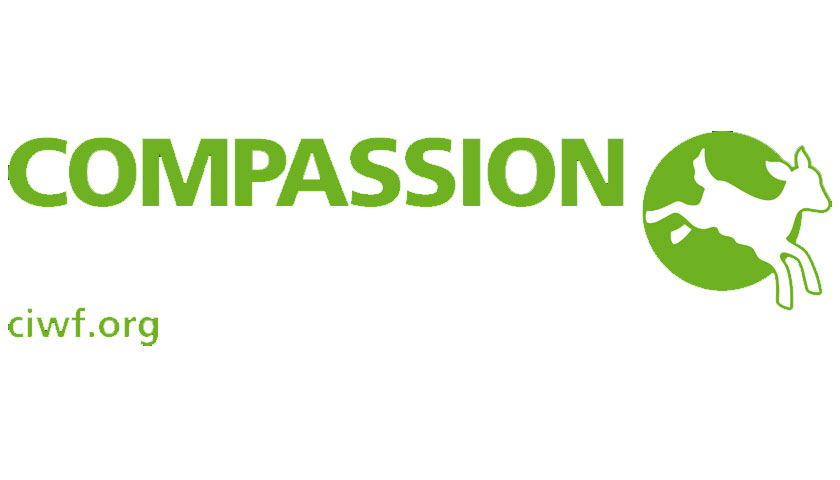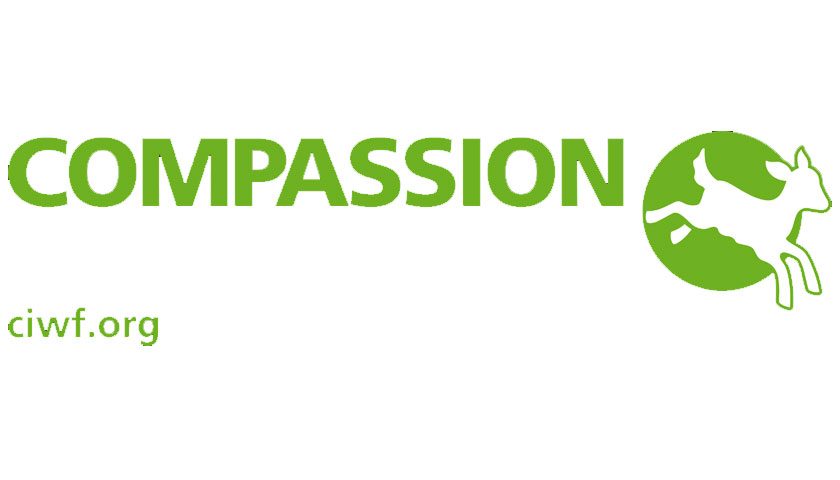Compassion in World Farming is boosting its efforts to improve the lives of the trillions of fish killed annually for human consumption, by launching phase two of its #RethinkFish campaign, encouraging the five major global fish certification schemes to set minimum standards to protect fish welfare.
Fish are sentient beings. They can feel pain, stress, and fear, as well as experience positive emotions, social bonds, and advanced intelligence. Raising awareness of their sentience – not a well-recognised trait in fish – was the focus of Compassion’s original #RethinkFish campaign launched at the end of 2018. Fish should therefore be protected, not just to minimise suffering but to enable a good quality of life and to ensure their welfare when they are caught and slaughtered.
The charity’s immediate focus for the next wave of the campaign is to ensure that the five global fish certification schemes – Marine Stewardship Council (MSC), Aquaculture Stewardship Council (ASC), GlobalG.A.P., Friends of the Sea (FoS) and Best Aquaculture Practice (BAP) – set minimum standards for fish welfare against each of the following criteria:
- Stocking density and overcrowding
- Enrichment provision
- Responsible antibiotic use
- Limiting time without feed
- Prohibiting harm to wild predators
- Humane slaughter
- Reducing demand of wild-caught fish for farmed fish feed
- Protecting welfare during capture of wild fish
These standards cover both wild caught fish (MSC and FoS) and aquaculture fish (ASC, GlobalG.A.P., BAP and FoS).
In recent years, there has been an increase in public awareness about animal welfare, sustainability, and healthy food, with many people turning to eating more fish as they decrease their red meat consumption. Many consumers refer to the labels of certification schemes on food packaging to guide their choice when purchasing fish and fish products, including the five schemes highlighted in this campaign. However, labels can be confusing as they don’t always mean the fish were reared, caught, and killed humanely.
An opinion poll carried out by Compassion in World Farming and YouGov[1] in the UK found that more than 60% of participants on average are not clear whether the certification schemes protect fish welfare, and the vast majority thought that they should introduce or strengthen the welfare criteria in their standards (e.g. 77% – agreed that humane slaughter methods should be introduced/strengthened).
The standards of the five certification bodies mainly focus on the environment, human rights, and for MSC and FoS, on the sustainability of fish stocks. While this is extremely important work, more needs to be done to introduce minimum standards to protect the welfare of all farmed fish during rearing, and all fish during capture and slaughter.
Overcrowding
In aquaculture, the stocking density of the fish is often high which affects many aspects of their lives. Fish stocked at high densities require more oxygen from the water and produce more waste which can affect water quality. Oxygen, temperature, lighting, and currents are not uniform in tanks, cages, and nets, and even in the most favourable environmental conditions, high densities limit the fishes’ ability to swim. High densities can also cause aggression leading to injuries and stress and limits the ability of subordinate fish to escape more dominant fish. Certifications schemes must therefore ensure fish are stocked at a lower density to promote their physical and mental wellbeing, by giving them the space to swim and get away from more dominant fish, to help reduce aggression, and to allow for better water quality.
Enrichment provision
For farmed fish to have good welfare, they should be able to perform natural behaviours and live in an interesting and complex environment that supports good mental wellbeing. Barren tanks, raceways and cages are not acceptable habitats. However, they can be enriched to give the fish more environmental complexity, which can in turn reduce stress and aggression, and allow them to engage more with their environment. For example, sea bass and sea bream habitually sift through substrates to forage and bury themselves in the sand to hide and rest, and salmonids hide themselves in rocks as protection against predators and bad weather. It is important that each species of fish receives the right type of enrichment for each stage of its life and it should be provided in the appropriate quantity and position to help decrease stress and avoid aggression.
ASC, GlobalG.A.P. and BAP do not require the provision of enrichment in their standards, and although FoS do not currently require enrichment to be provided, they are working towards this.
Antibiotic use
As with land animals, the routine use of antibiotics in fish farming is a symptom of poor husbandry conditions. It is a major problem as it contributes to antibiotic resistance, a huge threat to human health. This issue is one which is somewhat regulated by the certification schemes. ASC and FoS prohibit the prophylactic use of antibiotics, and BAP and GlobalG.A.P. have taken steps to reduce the use of antibiotics under their schemes.
In many countries, antibiotics have been regulated and consumers have become acutely aware of the risks associated with their overuse. Antibiotics are an important tool to restoring health when farmed fish become diseased due to a bacterial infection. However, the prophylactic or routine use of antibiotics results in bacteria developing resistance to these antibiotics, which in turn reduces the antibiotics’ effectiveness and the ability for farmers and veterinarians to treat and safeguard the health of farmed fish. All certification schemes must do their part to establish stricter standards for the responsible antibiotic use in fish farming.
Limiting time without feed
A common practice in aquaculture is the periodical starving of fish, particularly before transport and slaughter. This ensures that their digestive systems are empty to help maintain water quality during transport and to avoid contamination with faecal matter during slaughter.
The time required for the digestive system to empty varies between species and depends on the water temperature. Usually, 48-72 hours is sufficient time to empty the gut of most farmed species, however, certification schemes permit the unnecessary prolonged starving of fish which can last for several weeks. This causes great distress, weakened fish, and can lead to aggression and serious injuries.
Prohibiting harm to wild predators
Wildlife, including predators such as seals and sea birds, are often attracted to fish farms due to the abundance of food available to them. Predators are not only a nuisance to the farmers, but they also threaten their livelihoods, so it is not surprising that many farmers feel forced to protect their fish stock against predator attacks.
Compassion recommends the use of non-lethal exclusion methods, such as nets, provided that they are designed to avoid entanglement by the predator and are checked regularly. The majority of certification schemes highlighted in this campaign permit the killing of predators without any regulations and give limited guidance on predator control. ASC is the only exception as they do provide some guidelines on the killing of predators.
Humane slaughter
It’s not just during their lives that Compassion is campaigning for higher welfare standards for fish, humane slaughter practices are equally important. This means that they must be effectively stunned, rendered instantly insensible, and remain unconscious until death supervenes.
Inhumane methods of fish slaughter, for example, by submersion in a mixture of ice and water; suffocation in air; exposure to carbon dioxide; and bleeding without pre-stunning, cause considerable pain, fear and suffering which can be prolonged. Many fish remain conscious for hours during catching and processing and can suffer for several minutes after having their gills cut and left to bleed out.
While some progress is being made to improve the slaughter conditions for farmed fish, wild-caught fish commonly undergo inhumane capture and death. They are usually crowded in highly stocked nets during capture, then crushed under the weight of thousands of fish as the nets are hauled onto the ships. The fish are highly stressed, there is a high risk of injury and many of them die. The fish that do survive landing are then subject to suffocation until death occurs which can take over an hour or more. Neither MSC nor FoS currently protect the welfare of wild-caught fish in their standards by regulating capture and killing methods.
More humane methods of fish slaughter do exist and are being developed and adopted across the industry. In 2017, Tesco was awarded the Best Innovation Award at Compassion’s Good Farm Animal Welfare Awards for their leading work to introduce a humane slaughter system[2] for sea bass and sea bream into commercial practice. The fish are pumped onto the harvest vessel from their pens where they are electrically stunned and rendered unconscious which lasts to death following immersion in ice-slurry. Reducing stress before slaughter is not only more humane but has product quality benefits too.
The schemes which aim to protect wild-caught fish (MSC and FoS) currently have no guidelines for the humane capture and slaughter of fish. In aquaculture, aspects of humane slaughter are covered by some schemes (BAP, Global G.A.P, FoS are currently developing humane slaughter standards) but they need to be strengthened by providing effective specific guidelines for all species of fish.
Wild-caught fish for farmed fish feed
The welfare of wild fish caught to feed farmed fish is also an issue. Salmon, for example, are carnivorous and fed on diets high in fish meal made from swathes of wild-caught fish which also suffer from painful and stressful capture, and an inhumane death.
The fishmeal industry accounts for 0.5-1 trillion fish out of the 0.79-2.3 trillion fish caught every year. This is causing a global crisis in overfishing and putting pressure on the world’s ecosystem by taking away the feeding grounds for many species including sea birds and marine mammals. It is inherently unsustainable and certification schemes need to do more to help reduce the demand for wild-caught fish being used as fish feed by promoting alternative sources.
As we have seen in recent years with the changes in consumer attitudes towards cage-free eggs and a growing demand for improved broiler welfare, Compassion expects to see more consumers expressing their concerns for fish welfare as they become more aware of how fish are farmed and the associated knock-on effect it is having on sustainability and the environment. This will ultimately drive further change across the fish industry.
Compassion requires the certification schemes highlighted in this latest campaign to introduce or strengthen their standards for the different species of wild caught and farmed fish. In addition, companies with fish in their supply chains need to work with their suppliers to ensure that improvements are made, and higher welfare, more sustainable practices are adopted across the industry.
Dr Tracey Jones, Director of Food Business at Compassion said: “An increasing number of consumers are already beginning to question the welfare of fish and the impact modern aquaculture is having on the environment.
“Whilst some of the schemes identified in this campaign have some welfare requirements in place, they do not go far enough, and we urge them to strengthen their welfare standards for all farmed and wild-caught species.
“Assurance schemes and food companies have the power to influence animal welfare standards in the supply chain and although there are many challenges facing the industry, they are in a unique position to help the billions of fish that deserve a better life.”
To find out more about Compassion’s fish resources or to contact a Food Business Manager for advice, visit: https://www.compassioninfoodbusiness.com/resources/fish/
For a standards comparison table, visit: https://www.compassioninfoodbusiness.com/media/7440917/fish-labelling-schemes-comparison-table.pdf

